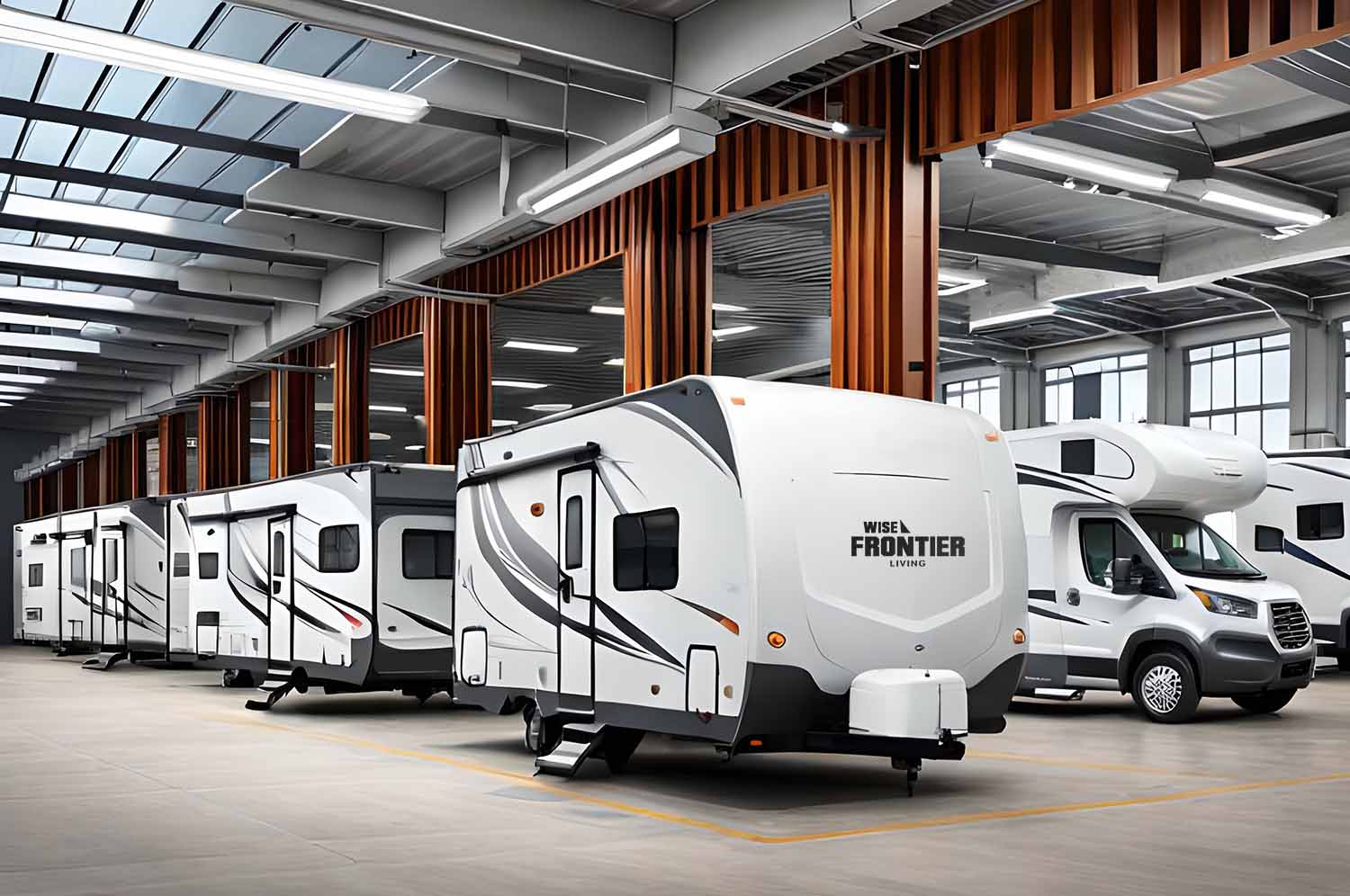If you’ve ever driven by an RV dealership, you’ve probably seen the vast number of RVs that are parked on their lot. You might be asking why RV retailers have such a large inventory of RVs.
Key Takeaways:
RV dealerships stock a wide range of RVs to meet potential buyer demands and prepare for the summer demand. In addition, they often take trade-ins, consignments, and manufacturer incentives which leads to an increase in their RV inventory.
Further in this article, we’ll discuss in detail the reasons behind the large inventory of RV dealerships along with tips on how to get the best deal on your RV. So keep reading till the end to explore more.
RV Dealers Prepare For Surge In Demand During Summer
Summer vacations and outdoor adventures are often linked with RVs. As a result, demand for RVs is stronger throughout the summer months. Families are planning road vacations and camping adventures, and they will need an RV to complete their journey.
RV dealers stock up during the off-season to fulfill summer demand. RV retailers recognize that the summer season is the best time to sell their vehicles.
They want to ensure buyers have a broad range of RVs to select from, so they bring in additional inventory during the off-season. This way, they can be certain they have enough RVs to handle the summer rise in demand.
Catering to Different Needs: Why RV Dealers Carry Diverse Inventory
RV dealerships approach sales differently than automobile dealerships. One of the most noticeable distinctions is the range of RV possibilities.
Although an automobile may only come in a few colors, RVs offer a variety of floor designs and features. As a result, potential buyers may not always know precisely what they want when they go onto the lot.
RV dealerships recognize this and strive to present their potential buyer with all of their alternatives.
By doing so, they may assist the consumer in making an educated selection and selecting an RV that meets their requirements. This is especially crucial for major RV stores with a greater inventory and more alternatives. Dealers may not always use the best practices when getting rid of inventory.
How RV Dealerships Keep Inventory Thriving: Trade-Ins And Consignments
RV dealerships always look for new and creative methods to keep their inventory fresh and attractive. Customers’ trade-ins and consignments are one method they do this.
When a consumer swaps in their old RV for a newer one, this is referred to as a trade-in. This is an excellent option for consumers to upgrade or downsize their RVs while also giving an opportunity for RV retailers to enhance their inventory of used RVs.
Customers seeking for a more economical choice might then be offered these used RVs by RV retailers.
When an RV owner decides to sell their RV via a dealership, this is known as a consignment. The dealership will then sell the RV on the owner’s behalf and collect a commission on the transaction.
This enables RV owners to sell their RV without the stress of finding a buyer and negotiating a price. RV dealerships may profit from both trade-ins and consignments by boosting their inventory of used RVs.
Used RVs are often cheaper for budget-conscious buyers, making them an excellent choice for people who want to enjoy the RV lifestyle without breaking the bank.
Once you understand why RV dealers have such extensive inventories, you’ll likely be interested in the overall cost of RV ownership.
How Manufacturer Incentives Lead To Stacked RV Dealerships
Manufacturers offering incentives is also one of the reasons that cause the RV dealerships to stock up a lot of RVs. Dealerships who buy a particular number of RVs may get discounts, rebates, or special promotions.
These incentives encourage dealerships to buy more inventory. For instance, a manufacturer may provide a dealership with a rebate for buying 10 or more RVs of a given type or size. This discount may make it viable for the dealership to buy additional inventory.
Also, several manufacturers may require dealerships to fulfill sales targets to obtain extra incentives. This might involve exclusive access to new models or inventory before other dealerships.
Manufacturers may provide promotions and sales events to entice dealerships to buy more inventory.
To fully grasp why RV dealers maintain extensive inventories, it’s helpful to know about the largest RV manufacturers and the brands they own.
How To Get The Best Deal At RV Dealership?
Now before we talk about some tips and suggestions on getting better deals at the dealership, let’s talk about the burning question that may be on your mind right now:
Can you get a better deal when the dealer has more inventory?
Well, the answer to that question is correct. A dealership with a lot of inventory may haggle on price to sell. This is particularly true for RVs that have been in stock for 6 months or longer.
Dealerships may discount these units to clear inventory. If a new RV has been in stock for a year or longer, the dealership may have to pay for it in full, which puts pressure on them to sell it ASAP.
So if you’re searching for a good price, seek dealerships with plenty of RVs, particularly ones that have been on the lot for a long.
Taking advantage of the dealer’s inventory is one technique to obtain a better bargain.
You may also seek for seasonal or promotional discounts, such as those offered during end-of-summer sales or Black Friday offers.
Another suggestion is to compare equivalent models at other dealerships. It’s possible that the same model RV may be priced differently at various dealerships, so do your homework and compare pricing before making a purchase.
Moreover, some dealerships may promote a sale price that is too good to be true, but they may not include all of the fees and extras that you’ll have to pay in addition to the selling price.
To ensure you receive the best deal, request the total ‘final’ price, which includes all fees and extras. This will give you a better sense of how much you’ll spend on the RV. When it comes to bargaining, there are a few key points to remember.
First, study the RV’s market worth and typical selling price. This can help you bargain more successfully and better understand what a reasonable price is.
It’s also critical to be ready to walk away if required. If you’re not comfortable with the price or conditions, don’t feel obligated to make a contract.
Remember that as the buyer, you have the authority to determine whether or not to make a purchase.
Another haggling tactic is to bargain for increased value. Ask for improvements or extras to be included in the transaction, or see if the dealership would throw in some free maintenance services.
Remember to learn about financing alternatives and conditions to make an educated decision about how to pay for your RV.
Lastly, try buying during the off-season to save money. Dealerships may be more likely to negotiate during slower seasons, such as winter or early spring, when fewer people want to purchase RVs.
Attending an RV tradeshow can be a great way to see a wide variety of RV models and types all in one place, and it can also provide an opportunity to compare prices and features across different dealerships. However, whether or not you can get a better deal on an RV at a tradeshow will depend on a few factors.
At a tradeshow, you may be able to find special promotions or discounts that are being offered by dealerships in order to attract customers. Additionally, because many dealerships will be competing with each other at the tradeshow, they may be willing to negotiate on price in order to make a sale.
However, it’s also worth noting that dealerships may not be able to offer the same level of customization or personalized service at a tradeshow that they would be able to provide at their own dealership. Additionally, it’s important to remember that RV prices are often influenced by factors such as demand and seasonality, so even if you can negotiate a good deal at a tradeshow, it may not be the best deal that’s available.
Ultimately, attending an RV tradeshow can be a great way to explore your options and get a sense of what’s available in the market, but it’s important to do your research beforehand and to be aware of the potential trade-offs involved in making a purchase at a tradeshow.
If you find yourself in place where people are using a bunch of RV lingo, then you might find it helpful to familiarize yourself with common RV terms and definitions.”
Can You Get a Better Deal on RVs at a Tradeshow?
I’ve attended several RV tradeshows throughout the years, and prices fluctuate based on the stock of seasonality. At my last major RV tradeshow in 2023, I saw deals where you could save as much as 28.0%.

Attending an RV tradeshow can be a great way to see a wide variety of RV models and types all in one place, and it can also provide an opportunity to compare prices and features across different dealerships. However, whether or not you can get a better deal on an RV at a tradeshow will depend on a few factors.
At a tradeshow, you may be able to find special promotions or discounts that are being offered by dealerships in order to attract customers. Additionally, because many dealerships will be competing with each other at the tradeshow, they may be willing to negotiate on price in order to make a sale.
However, it’s also worth noting that dealerships may not be able to offer the same level of customization or personalized service at a tradeshow that they would be able to provide at their own dealership. Additionally, it’s important to remember that RV prices are often influenced by factors such as demand and seasonality, so even if you can negotiate a good deal at a tradeshow, it may not be the best deal that’s available.
Ultimately, attending an RV tradeshow can be a great way to explore your options and get a sense of what’s available in the market, but it’s important to do your research beforehand and to be aware of the potential trade-offs involved in purchasing a tradeshow.
If you ever wondered if you can save money by registering your RV in another state? Then check out this article on understanding the intricacies of registering your RV in another state.
Do RV Dealers Own Their Inventory?
RV dealerships may or may not own their inventory, depending on their business model and agreements with manufacturers. Here are some possible scenarios:
- Consignment sales: Some dealerships may operate on a consignment basis, where RV owners place their vehicles on the dealer’s lot to sell. In this case, the dealership does not own the inventory and only receives a commission on the sale.
- Floor plan financing: Many dealerships use floor plan financing to purchase their inventory from manufacturers. This means that the dealership takes out a loan to buy the RVs from the manufacturer and only pays it back once the vehicles are sold. In this case, the dealership technically owns the inventory but has a debt to pay off.
- Manufacturer-owned inventory: Some manufacturers may own and operate their own dealerships, in which case they would own the inventory sold at those locations.
- Other ownership models: There may be other ownership models depending on the dealership and manufacturer, such as leases or partnerships.
